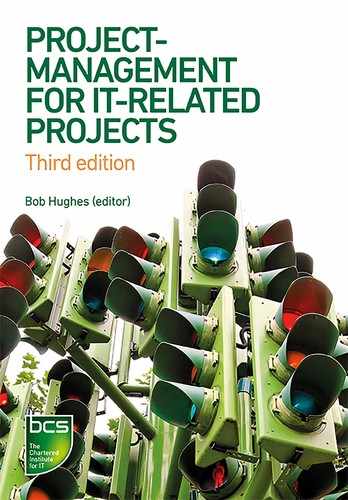PREFACE
This book aims to give a practical introduction to fundamental IT project management principles and techniques. The first edition was written with the specific purpose of providing learning material to candidates for the BCS Foundation Certificate in IS Project Management. The second edition still supported this qualification, but updated some of the material and broadened its practical application.
Taking this qualification is not itself a daunting challenge. It consists of an hour-long 40-question multiple choice examination. However, the intention was never just to help cram for an examination. While there might be an immediate concern to pass a test, for most people the more important motivation was to gain guidance on planning and managing an IT project. The text was designed to help those from an IT practitioner background who were beginning to take on project management responsibilities. It might also give IT users some insights into IT project management issues. The book therefore goes beyond simply helping people to tick the right boxes in a test and aspires to support novice IT project leaders in their place of work.
With any new topic, a good starting point is a text which provides a simple explanation of the basics. Having grasped the basics, you can then go on and explore more advanced concepts. A measure of the success of the previous editions was that they started to be used for purposes for which they were not primarily designed. One example of this was the BCS Higher Education Qualification Diploma in IT Project Management (an ‘academic’ BCS qualification comparable to a UK university award and taken mainly by overseas candidates).
However, the focus still remains on the foundations – there is only so much you can cram into a three-day course – but care has been taken here to provide links to other, more detailed project management material. Wherever possible, alternatives to the terminology we have used are provided for techniques and concepts to allow easier cross-reference to other bodies of knowledge. For example, ‘steering committee’, ‘project board’ and ‘project management board’ all refer to largely the same concept in project management.
We have put in links to further material using a ![]() symbol for those who want to explore a topic more deeply. Some material in the basic text goes beyond what is needed for the BCS Foundation syllabus and these have been marked with a
symbol for those who want to explore a topic more deeply. Some material in the basic text goes beyond what is needed for the BCS Foundation syllabus and these have been marked with a ![]() symbol to indicate an ‘advanced topic’.
symbol to indicate an ‘advanced topic’.
It may be heretical to say this in a project management book, but successful projects depend on more than good project management and some of the links provided are to material on complementary disciplines that can assist positive project outcomes. (The BCS International Diploma in Business Analysis, to which the Foundation Certificate in IS Project Management can contribute, supports this view.)
The BCS Foundation Diploma syllabus has been very stable in recent years and there have been no massive changes in content in this (third) edition. The immediate motivation was to update outdated references, particularly to standards, so that, for example, we refer to the ISO 25000 series of standards on software quality requirements rather than ISO 9126. However, we have taken more care to acknowledge that IT projects increasingly involve implementing existing functionality provided by vendors and writing business software from scratch is less prevalent. Where software is developed, Agile approaches are now common. The main principles of project agility – such as the focus on iterations and increments in project delivery – had been well-established before the term ‘agile’ was adopted in the context of software development, so it has been easy to signpost those elements of our approach that dealt with them.
In this edition we have attempted to reduce reliance on PRINCE2 concepts and terminology. PRINCE2 is a UK government-sponsored set of procedures for managing major projects that is administered by Axelos, a venture jointly owned by Capita and the UK government. In our view, it effectively describes an information system for a project that allows it to be run in a controlled and efficient manner. Although PRINCE2 is really an administrative standard that will tell you what decisions need to be taken and when, it does not claim to be a set of project management principles and techniques.
There is an understandable tendency for IT project management to lose the ‘IT’ and be treated as just project management. We want to resist this. It is certainly true that IT projects are often parts of broader business change programmes. It is frequently argued that technical expertise is unnecessary for professional project managers who can move successfully between different industry and business sectors, and it is certainly true that great software engineers are frequently unsuited to or uninterested in project management. But project management is not just a matter of persuasive communication. A glib personality can sell courses of action which are just plain wrong. Leadership includes providing guidance on the best ways of meeting the challenges of applying technologies to meet organisational objectives based on sound evidence. Successful IT leaders cannot know everything about IT, but they need a solid understanding of the professional practices involved in IT. They need to know how to develop and exploit the skills and expertise of a range of people from different disciplines.
We hope this book will help you to plan and manage your IT and software projects. By a happy coincidence, the last day of my work on the new edition has coincided with the 50th anniversary of the Apollo 11 landing on the moon. Individuals can do good, but to achieve true greatness we need to work together.
